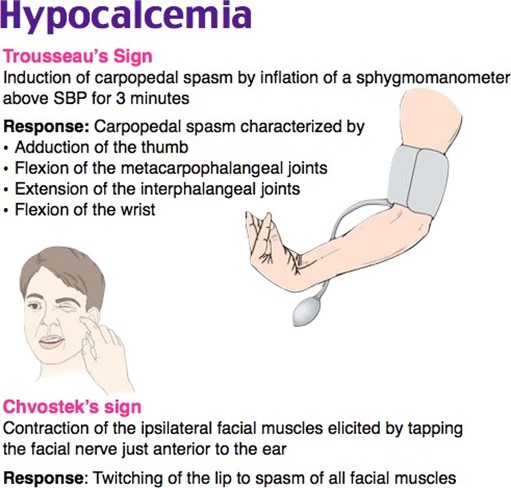The nurse is concerned that a patient recovering from a thyroidectomy is developing hypocalcemia. What findings did the nurse use to come to this conclusion? Select all that apply.
Contraction of the facial muscles.
Complaints of fingers tingling.
Carpal spasm with blood pressure measurement.
Asked when the foot numbness would go away.
Correct Answer : A,B,C
Choice A rationale:

The nurse considered contraction of facial muscles as a finding of hypocalcemia because it is associated with Chvostek's sign, which indicates neuromuscular irritability due to low calcium levels.
Choice B rationale:
Complaints of fingers tingling are indicative of hypocalcemia since tingling sensations (paresthesias) in the extremities can result from decreased calcium levels affecting nerve function.
Choice C rationale:
Carpal spasm with blood pressure measurement is known as Trousseau's sign and is associated with hypocalcemia. When the blood pressure cuff is inflated above systolic pressure, it can cause tetany in the hand if the calcium levels are low.
Choice D rationale:
Asking when foot numbness would go away does not directly relate to hypocalcemia or its symptoms. It is not a finding used to come to the conclusion of hypocalcemia in this scenario.
Choice E rationale:
The heart rate being 88 and regular does not directly indicate hypocalcemia. While hypocalcemia can lead to cardiac arrhythmias, a heart rate of 88 and regular is within the normal range and not a specific finding for hypocalcemia.
Nursing Test Bank
Naxlex Comprehensive Predictor Exams
Related Questions
Correct Answer is B
Explanation
Other electrolyte disturbances.
Choice A rationale:
Drug toxicity is not directly related to hypocalcemia. The main concern in hypocalcemia is the calcium imbalance itself, not drug toxicity.
Choice B rationale:
Other electrolyte disturbances should be assessed because imbalances in other electrolytes, such as potassium and magnesium, are often associated with hypocalcemia. Electrolyte imbalances can interact and exacerbate each other, potentially leading to more severe complications.
Choice C rationale:
Hypertension is not a typical assessment finding in hypocalcemia. Hypertension is not directly related to calcium levels but may have other underlying causes.
Choice D rationale:
Visual disturbances are not commonly associated with hypocalcemia. Hypocalcemia is more likely to present with neuromuscular and cardiovascular symptoms, rather than visual disturbances.
Correct Answer is ["A","D"]
Explanation
The correct answer is A. Limit intake of canned soups and D. Read labels on foods before eating.
Choice A rationale:
Canned soups often contain high levels of sodium, which can contribute to exceeding the recommended daily sodium intake. Limiting these can help manage sodium levels effectively.
Choice B rationale:
Choosing diet sodas over bottled water is not advisable. Diet sodas can still contain sodium and other additives that are not beneficial for a low-sodium diet. Bottled water is a better choice as it typically contains no sodium.
Choice C rationale:
Bottled salad dressings often contain high amounts of sodium. Opting for homemade or low-sodium versions is a better strategy for maintaining a low-sodium diet.
Choice D rationale:
Reading labels on foods before eating is crucial for identifying hidden sources of sodium and making informed dietary choices. This practice helps in adhering to a low-sodium diet by avoiding foods with high sodium content.
: 3
Whether you are a student looking to ace your exams or a practicing nurse seeking to enhance your expertise , our nursing education contents will empower you with the confidence and competence to make a difference in the lives of patients and become a respected leader in the healthcare field.
Visit Naxlex, invest in your future and unlock endless possibilities with our unparalleled nursing education contents today
Report Wrong Answer on the Current Question
Do you disagree with the answer? If yes, what is your expected answer? Explain.
Kindly be descriptive with the issue you are facing.
